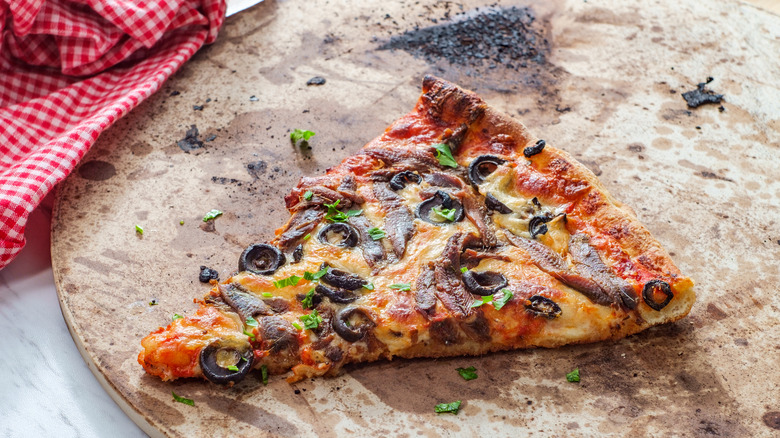Could You Use A Pizza Stone Without A Pizza Peel?
Pizza might originally be from Italy (per History), but it has become so well-loved in the United States that it might be giving the Mediterranean nation a run for its money. Martha Stewart reports that a OnePoll survey found 94% of participants claimed to have had pizza at least once in the month prior to participating in the survey, and 72% said that they could eat it for all three meals.
While there's also certainly no shortage of neighborhood pizza shops, there's also something admirable about perfecting homemade pizza. And Good Housekeeping says that there is an abundance of home pizza oven options on the market these days to help assist with this task. It's even possible to DIY your own backyard oven to get that classic woodfired taste without leaving your home.
Whatever your preferred cooking option though, there is some equipment that is a necessity for making the best pizzas at home. Arguably, fresh mozzarella is among those items, but what about a pizza peel? It might seem like an unnecessary purchase, but if you're planning to use a pizza stone for your homemade pie, you'll have to keep one on hand.
What is a pizza stone?
According to Forno Bravo, pizza stones, or similar variants, have been used in cooking for thousands of years. Placing stones in fire pits was a way for stone age humans to create a more controlled cooking surface before the invention of metal cookware. Today, stones are still used but are placed inside of modern ovens to provide an evenly heated cooking surface.
BBC goodfood says that pizza stones are especially valued for their ability to absorb moisture as well. Pizza stones can be used for cooking and baking a variety of foods, but these properties make them especially valued for creating crisp, delicious pizza crusts.
Popular Mechanics claims that while pizza stones can give a stronger blast of initial heat than metal surfaces, they aren't absolutely required for good homemade pizza. If you're painstakingly measuring every drop of water that goes into your dough, and then tossing it around your kitchen though you'll want any advantage you can get on industrial pizza ovens. And if that's the case, you're going to need a pizza peel to go with it.
If you use a stone, you'll need a peel
As Popular Mechanics points out, one of the main advantages of the pizza stone is its ability to hold heat. That means that when your pizza first makes contact with the cooking surface, it will absorb that increased heat, and give a lift to your dough. This creates that coveted crisp bottom surface, with a pillowy soft interior that is the sign of a well-made pizza.
Placing the pizza onto this scalding hot stone without losing any of the toppings or burning yourself can be quite the challenge though. That's where the pizza peel comes in. Giordano's says that pizza peels allow you to easily place your pizza onto that hot surface. It is essentially a large spatula that you assemble the pizza on to easily place it in the oven or on a stone. With a properly floured pizza peel and a little know-how, the pizza will slide easily onto the hot stone every time.
It's up to you to weigh the benefits of cooking with a pizza stone, but if you choose to use a stone, make sure to get a peel as well.


